Sustainable transportation options in Southern Europe offer significant benefits, including reduced carbon emissions and improved urban livability. This article explores various types of sustainable transportation, such as public transit, cycling, and electric vehicles, while examining their environmental impact and economic advantages. It also addresses cultural attitudes and innovative technologies shaping these transportation methods, alongside the challenges faced in implementation.
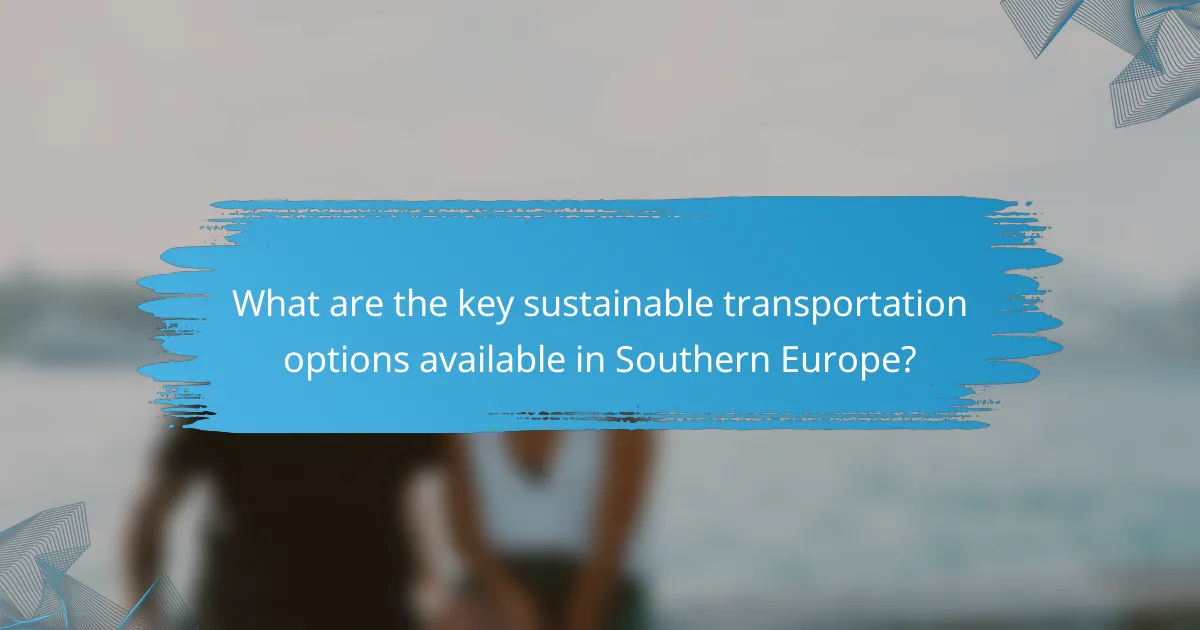
What are the key sustainable transportation options available in Southern Europe?
Sustainable transportation options in Southern Europe include public transit, cycling, walking, and electric vehicles. These options reduce carbon emissions and promote healthier lifestyles.
Public transit systems, such as buses and trains, are widely available and efficient. They significantly lower individual carbon footprints compared to private vehicles. Cycling infrastructure is expanding, encouraging eco-friendly commuting. Walking paths enhance pedestrian safety and accessibility, promoting a cleaner environment.
Electric vehicles are gaining popularity, supported by government incentives and charging infrastructure. These vehicles contribute to reduced air pollution and lower greenhouse gas emissions. Collectively, these sustainable options foster a more environmentally friendly transportation ecosystem in Southern Europe.
How do electric vehicles contribute to sustainable transportation?
Electric vehicles significantly enhance sustainable transportation by reducing greenhouse gas emissions and promoting energy efficiency. They operate on electricity, which can be sourced from renewable energy, minimizing reliance on fossil fuels. In Southern Europe, the adoption of electric vehicles supports local economies by creating jobs in green technology and infrastructure. Furthermore, electric vehicles contribute to improved air quality, benefiting public health and the environment. Their integration into urban planning fosters the development of charging infrastructure, encouraging more sustainable travel options.
What role do bicycles play in promoting eco-friendly travel?
Bicycles significantly promote eco-friendly travel by reducing carbon emissions and congestion. They serve as a sustainable transportation option in Southern Europe, offering health benefits and cost-effectiveness. For example, cycling decreases reliance on fossil fuels, contributing to cleaner air and lower traffic noise. Additionally, cities with extensive bike lanes experience improved urban mobility and enhanced quality of life.
How is public transportation evolving towards sustainability?
Public transportation in Southern Europe is evolving towards sustainability through various innovative options. Electric buses and trams are increasingly common, reducing emissions and improving air quality. Bike-sharing programs and pedestrian-friendly initiatives enhance mobility while promoting healthier lifestyles. The integration of smart technology optimizes routes and schedules, further increasing efficiency. As a result, these sustainable transportation options contribute significantly to reducing carbon footprints and fostering environmentally friendly urban environments.
What are the benefits of walking as a sustainable transport option?
Walking as a sustainable transport option offers numerous benefits, including reduced carbon emissions, improved public health, and enhanced community connectivity. It decreases reliance on motor vehicles, leading to less traffic congestion and lower air pollution levels.
Walking promotes physical fitness, contributing to overall well-being. Studies show that regular walking can lower the risk of chronic diseases, such as heart disease and obesity. Furthermore, walkable communities often experience increased social interactions, fostering a sense of belonging and safety among residents.
Additionally, walking is cost-effective, requiring no fuel or maintenance expenses associated with vehicles. It supports local economies by encouraging foot traffic to shops and services. Overall, walking enhances the sustainability of urban environments, benefiting both individuals and communities.
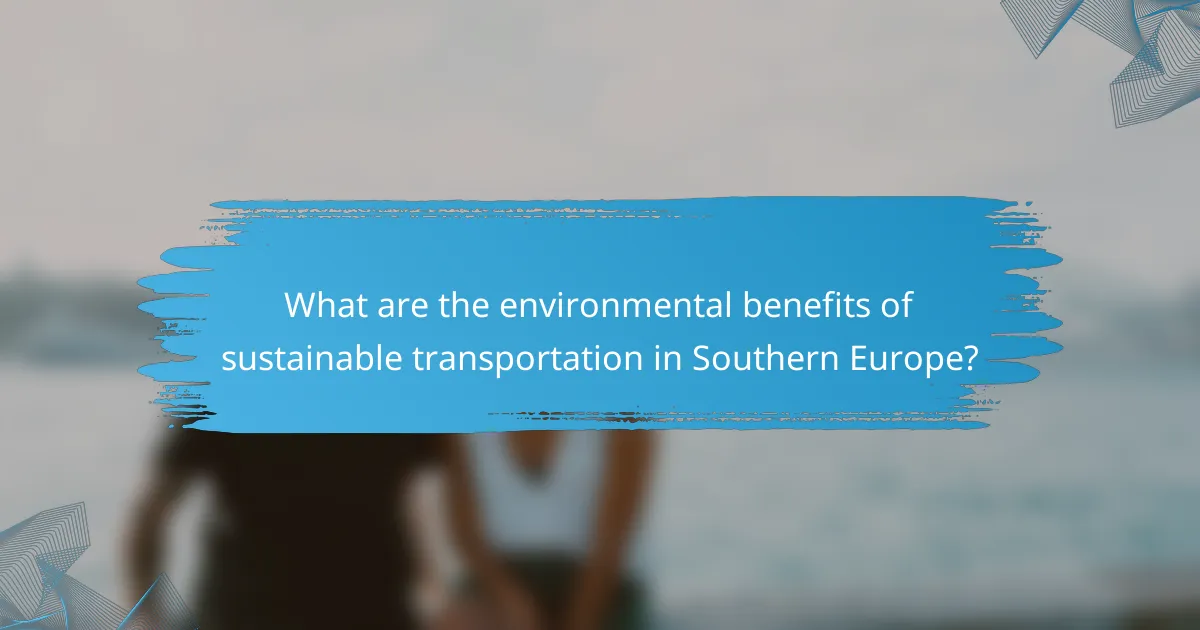
What are the environmental benefits of sustainable transportation in Southern Europe?
Sustainable transportation in Southern Europe offers significant environmental benefits, including reduced greenhouse gas emissions, improved air quality, and conservation of natural resources. These options, such as cycling, public transit, and electric vehicles, contribute to lower carbon footprints and enhanced urban livability.
Sustainable transportation reduces reliance on fossil fuels, promoting energy efficiency. For instance, electric buses produce zero tailpipe emissions, which directly improves urban air quality. Furthermore, increased use of public transport can lead to a decrease in traffic congestion, resulting in less pollution and reduced noise levels.
Additionally, sustainable transportation encourages the development of green spaces. Cities that prioritize walking and cycling infrastructure often see an increase in parks and recreational areas, enhancing biodiversity and community well-being. This shift not only benefits the environment but also promotes healthier lifestyles among residents.
In summary, the environmental benefits of sustainable transportation in Southern Europe include lower emissions, improved air quality, and the promotion of green spaces. These factors collectively contribute to a healthier and more sustainable urban environment.
How does reduced carbon emissions impact local ecosystems?
Reduced carbon emissions positively impact local ecosystems by enhancing air quality and promoting biodiversity. Sustainable transportation options, such as electric vehicles and public transit, reduce greenhouse gases, leading to healthier habitats. This shift decreases pollution levels, benefiting flora and fauna. Improved air quality supports plant growth and animal health, fostering resilient ecosystems.
What is the significance of improved air quality for urban populations?
Improved air quality significantly enhances urban populations’ health and well-being. Cleaner air reduces respiratory diseases, promotes better cardiovascular health, and increases overall life expectancy. For example, cities with effective sustainable transportation options see lower pollution levels, leading to healthier communities. Additionally, enhanced air quality fosters economic benefits, as healthier populations contribute more effectively to the workforce.
How do sustainable transportation options contribute to climate change mitigation?
Sustainable transportation options significantly contribute to climate change mitigation by reducing greenhouse gas emissions. These options include public transit, cycling, and walking, which lower reliance on fossil fuels. For instance, electric buses produce zero tailpipe emissions, enhancing urban air quality. Additionally, promoting cycling can reduce city congestion and carbon footprints by up to 45% in some areas. Transitioning to sustainable transportation fosters cleaner environments and supports climate action goals.

How do cultural attitudes towards transportation influence sustainability efforts?
Cultural attitudes towards transportation significantly shape sustainability efforts by influencing public acceptance and adoption of eco-friendly options. In Southern Europe, a strong emphasis on traditional modes like cycling and public transit promotes sustainable practices.
Countries like Spain and Italy showcase cultural pride in walking and using trams, leading to lower carbon footprints. For instance, cities like Barcelona have invested in extensive bike lanes, reflecting a community-driven approach to sustainability.
Public awareness campaigns further enhance this shift, as they educate citizens on the benefits of sustainable transportation. As a result, urban planning increasingly prioritizes green spaces and pedestrian-friendly infrastructure, fostering a culture of sustainability.
This integration of cultural values creates a unique attribute of Southern European cities, setting them apart in their commitment to sustainable transportation.
What are the common perceptions of public transport in Southern European countries?
Public transport in Southern European countries is often perceived as convenient but sometimes unreliable. Many view it as a sustainable alternative, promoting reduced traffic and lower emissions. However, issues like overcrowding and maintenance can affect satisfaction. Public transport systems vary, with some cities investing in modern fleets and infrastructure, enhancing user experience.
How do local communities engage with sustainable mobility initiatives?
Local communities actively participate in sustainable mobility initiatives by promoting public transport, cycling, and walking. These efforts enhance accessibility, reduce emissions, and foster community engagement. For example, cities in Southern Europe implement bike-sharing programs and pedestrian-friendly zones, leading to increased usage of sustainable transport options. As a result, these initiatives contribute to improved air quality and public health. Furthermore, community workshops and awareness campaigns help educate residents on the benefits of sustainable mobility, encouraging wider adoption.
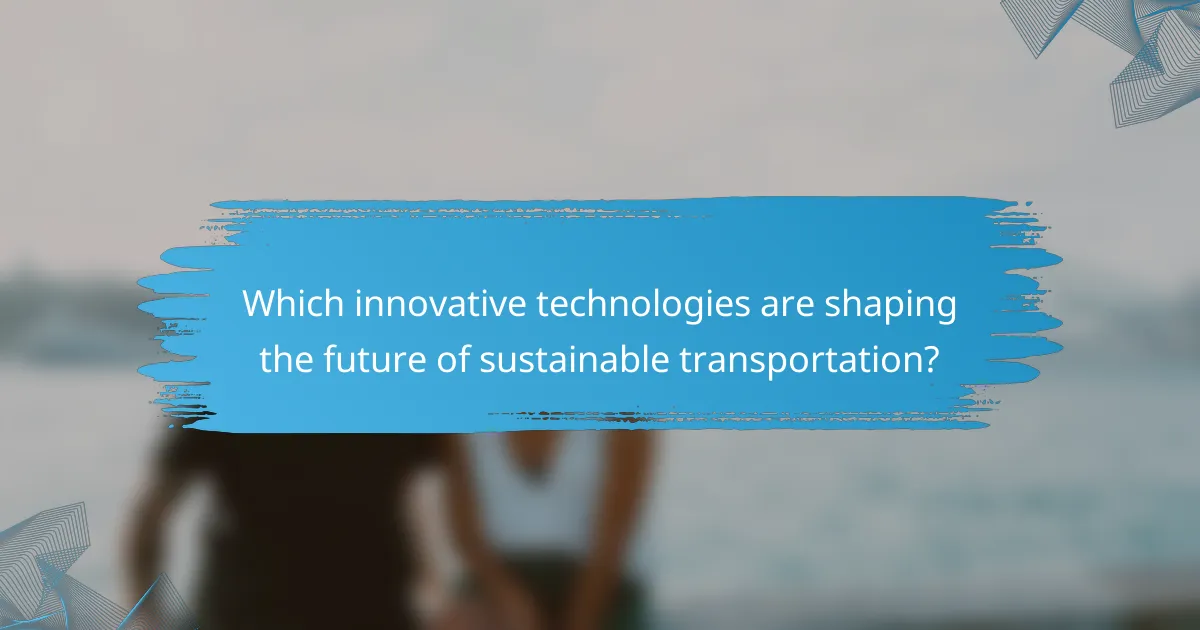
Which innovative technologies are shaping the future of sustainable transportation?
Innovative technologies like electric vehicles, hydrogen fuel cells, and smart public transit systems are shaping sustainable transportation in Southern Europe. These advancements reduce emissions and enhance efficiency.
Electric vehicles (EVs) are gaining traction due to their zero-emission nature and reduced operating costs. As battery technology improves, EVs offer longer ranges and faster charging times. Hydrogen fuel cells provide an alternative, emitting only water vapor while powering vehicles.
Smart public transit systems utilize real-time data to optimize routes and schedules, improving user experience and reducing congestion. Integration of bike-sharing and electric scooters further enhances urban mobility, promoting eco-friendly travel options.
These technologies collectively contribute to a cleaner environment and sustainable urban development in Southern Europe.
How are smart city initiatives integrating sustainable transport solutions?
Smart city initiatives are effectively integrating sustainable transport solutions through various means. These include the promotion of electric public transport, expansion of cycling infrastructure, and implementation of smart traffic management systems.
Electric buses and trams reduce emissions and improve air quality. Cycling infrastructure encourages eco-friendly commuting, fostering a healthier urban environment. Smart traffic management uses real-time data to optimize traffic flow, reducing congestion and energy consumption.
In cities like Barcelona and Lisbon, these solutions have led to a significant decrease in carbon footprint and improved residents’ quality of life. The integration of these sustainable transport options demonstrates a commitment to environmental responsibility and urban resilience.
What advancements in battery technology are impacting electric vehicles?
Advancements in battery technology are significantly enhancing electric vehicles. Innovations such as solid-state batteries improve energy density and safety, while fast-charging capabilities reduce downtime. Additionally, increased recycling efforts for battery materials promote sustainability in the automotive sector. These advancements collectively contribute to the growing adoption of electric vehicles in Southern Europe, aligning with sustainable transportation goals.

What challenges do Southern European cities face in implementing sustainable transportation?
Southern European cities face significant challenges in implementing sustainable transportation. Key obstacles include financial constraints, inadequate infrastructure, and resistance to change from traditional transportation modes.
Financial limitations hinder investment in new technologies and public transit systems. Many cities struggle to allocate resources for sustainable initiatives, leading to slow progress.
Inadequate infrastructure often fails to support sustainable options like cycling and walking. Poorly designed urban environments can discourage the use of public transport.
Resistance from citizens and businesses to shift from established practices presents a cultural challenge. Many individuals prefer personal vehicles due to convenience, complicating efforts to promote public transit and shared mobility solutions.
Addressing these challenges requires coordinated efforts among governments, private sectors, and communities to foster a more sustainable urban transport landscape.
How does urban infrastructure affect the adoption of eco-friendly transport?
Urban infrastructure significantly influences the adoption of eco-friendly transport by providing necessary facilities and connectivity. Well-designed urban environments promote cycling and walking through bike lanes and pedestrian pathways. Access to public transport hubs enhances the viability of electric buses and trams. Additionally, green spaces contribute to a healthier atmosphere, encouraging residents to choose sustainable transport options. As a result, cities with robust infrastructure see higher rates of eco-friendly transportation adoption.
What are the financial barriers to developing sustainable transport systems?
Financial barriers to developing sustainable transport systems include high initial investments, limited funding sources, and economic instability. Many regions in Southern Europe face challenges in securing public and private investments. Additionally, the transition from traditional to sustainable systems requires extensive infrastructure upgrades, which can strain budgets.
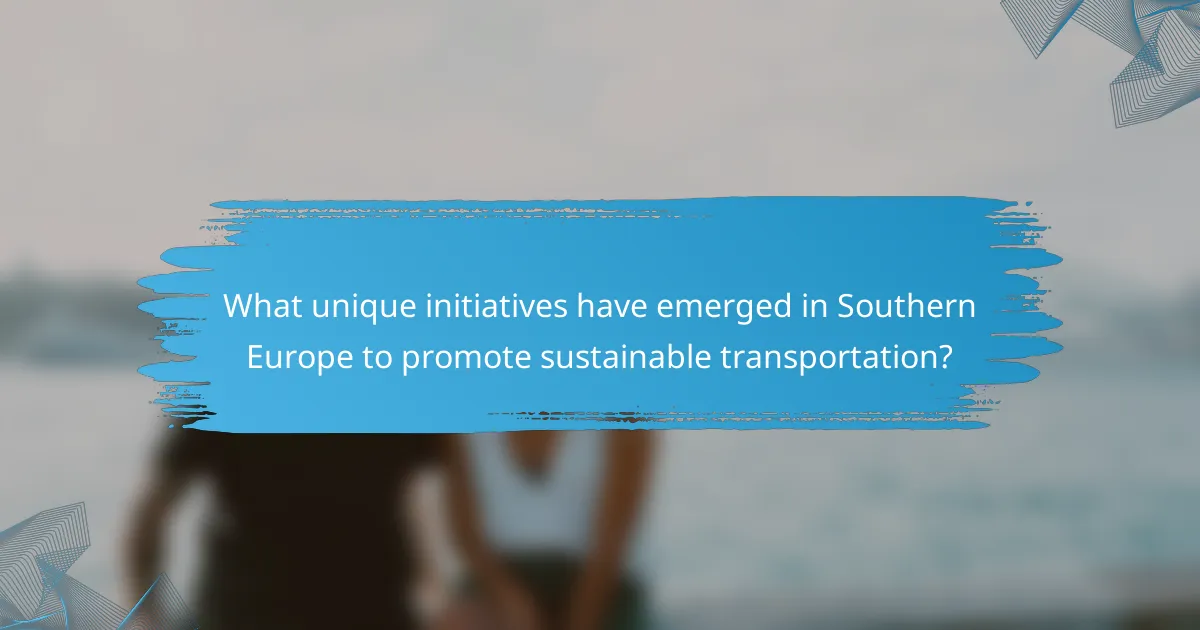
What unique initiatives have emerged in Southern Europe to promote sustainable transportation?
Innovative initiatives in Southern Europe focus on enhancing sustainable transportation through electric vehicle incentives, bike-sharing programs, and improved public transit systems. For example, cities like Barcelona and Lisbon promote electric mobility with charging infrastructure and subsidies. Additionally, regional governments support cycling by expanding bike lanes and facilitating bike-sharing schemes, improving accessibility and reducing carbon footprints. These initiatives collectively aim to create greener urban environments and promote eco-friendly commuting options.
How are local governments incentivizing the use of electric bikes?
Local governments in Southern Europe are incentivizing electric bike use through subsidies, infrastructure development, and awareness campaigns. Financial incentives, such as grants or tax reductions, lower purchase costs for consumers. Investment in dedicated bike lanes enhances safety and convenience, encouraging more riders. Public campaigns promote the environmental benefits of electric bikes, fostering a culture of sustainable transportation. These strategies collectively aim to reduce urban congestion and emissions while improving public health.
What role do community-led projects play in enhancing sustainable transport?
Community-led projects significantly enhance sustainable transport by fostering local engagement and prioritizing specific needs. These initiatives often lead to tailored solutions, such as improved cycling infrastructure or car-sharing programs, which directly address community concerns. As a result, they promote greater use of sustainable transportation options and reduce reliance on fossil fuels. Additionally, these projects can increase awareness of environmental impacts, encouraging more individuals to adopt eco-friendly practices. Ultimately, community involvement leads to innovative ideas and a stronger commitment to sustainability in transport.

What are the economic impacts of sustainable transportation on Southern European cities?
Sustainable transportation significantly boosts the economy of Southern European cities by enhancing mobility, reducing congestion, and promoting tourism. It creates jobs in green sectors and lowers transportation costs for residents.
Investments in public transit systems, cycling infrastructure, and pedestrian-friendly areas stimulate local economies. For instance, cities like Barcelona and Milan have seen increased property values and local business growth due to improved accessibility.
Additionally, sustainable transportation reduces environmental costs associated with air pollution and traffic accidents. This leads to healthier populations and lower healthcare expenses, further benefiting local economies.
Overall, sustainable transportation fosters economic resilience and supports long-term urban development in Southern Europe.
How does sustainable transport influence local job creation?
Sustainable transport significantly boosts local job creation by developing new industries and enhancing existing ones. Investments in green transportation options, such as electric buses and cycling infrastructure, create jobs in manufacturing, maintenance, and operations. For instance, the European Union reported that sustainable transport initiatives could generate up to 1.5 million jobs by 2030. Additionally, these options improve accessibility, leading to increased local business revenues and further job opportunities. As a result, communities benefit from a more robust economy and reduced unemployment rates.
What are the cost savings associated with reduced reliance on fossil fuels?
Reduced reliance on fossil fuels can lead to significant cost savings in transportation. These savings arise from decreased fuel expenses, lower maintenance costs, and potential government incentives for sustainable practices.
Transitioning to electric or hybrid vehicles can reduce fuel costs by up to 50%, depending on local energy prices. Additionally, electric vehicles generally require less maintenance due to fewer moving parts, resulting in savings over time.
Investing in public transportation systems can also reduce overall transportation costs for communities. Enhanced public transport options can lead to reduced traffic congestion, lowering costs associated with road maintenance and accidents.
Furthermore, governments may offer tax breaks or subsidies for adopting sustainable transportation, providing additional financial benefits to individuals and businesses.
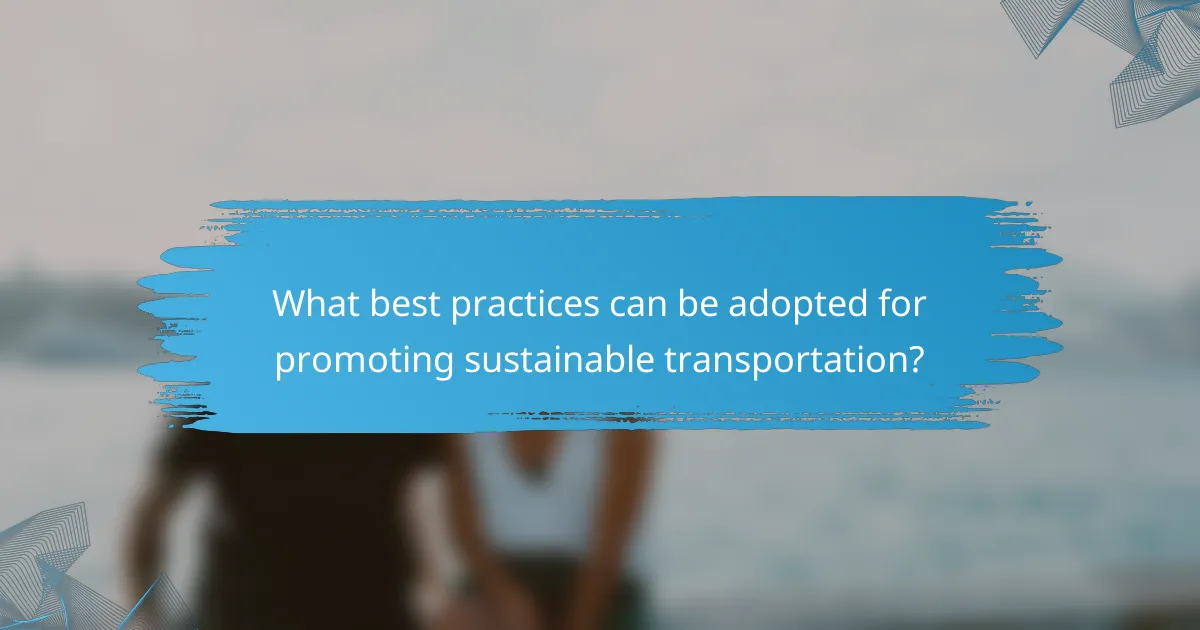
What best practices can be adopted for promoting sustainable transportation?
Adopting best practices for promoting sustainable transportation involves a multifaceted approach. Encourage the use of public transport by enhancing accessibility and reliability. Promote cycling and walking through improved infrastructure, such as dedicated bike lanes and pedestrian zones. Implement awareness campaigns highlighting the environmental benefits and cost savings of sustainable options. Collaborate with local businesses and governments to create incentives for using eco-friendly transportation modes. Leverage technology for real-time information on transport options to facilitate smarter travel choices.
How can cities effectively encourage public transport usage?
Cities can effectively encourage public transport usage by implementing integrated transport systems, enhancing accessibility, and promoting awareness. Improved connectivity between various transport modes increases convenience, making public transport a viable option. For example, cities can develop dedicated bus lanes and expand metro networks to reduce travel times.
Additionally, offering incentives such as discounted fares or free transfers can attract more users. Awareness campaigns highlighting the environmental benefits and cost savings of public transport can further boost ridership. Cities can also invest in user-friendly technology, such as mobile apps for real-time tracking, to enhance the overall experience.
Finally, creating pedestrian-friendly environments near transit hubs encourages walking to stations, increasing public transport usage. By focusing on these strategies, cities can foster a sustainable transportation culture that benefits both residents and the environment.
What strategies can be employed to enhance cycling infrastructure?
Implementing enhanced cycling infrastructure requires strategic planning and investment. Key strategies include developing dedicated bike lanes, increasing bike-sharing programs, and improving connectivity with public transport.
1. Develop dedicated bike lanes to ensure cyclist safety and promote usage.
2. Increase accessibility and availability of bike-sharing programs in urban areas.
3. Implement traffic calming measures to reduce vehicle speeds in cycling zones.
4. Enhance connectivity between cycling paths and public transportation hubs.
5. Promote community engagement to gather input and encourage cycling culture.
What common mistakes should be avoided when implementing sustainable transport policies?
Common mistakes to avoid when implementing sustainable transport policies include neglecting stakeholder engagement, failing to consider local context, underestimating funding needs, and overlooking the importance of data collection. Engaging communities ensures policies meet real needs. Local context is crucial for effectiveness; what works in one area may not in another. Adequate funding is essential for successful implementation and maintenance. Lastly, robust data collection helps measure impact and inform future decisions.